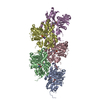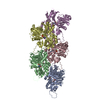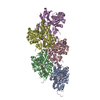+ データを開く
データを開く
- 基本情報
基本情報
| 登録情報 | データベース: PDB / ID: 8oi6 | ||||||||||||
|---|---|---|---|---|---|---|---|---|---|---|---|---|---|
| タイトル | Cryo-EM structure of the undecorated barbed end of filamentous beta/gamma actin | ||||||||||||
 要素 要素 |
| ||||||||||||
 キーワード キーワード | STRUCTURAL PROTEIN / Actin filament / cytoskeletal protein / ATPase | ||||||||||||
| 機能・相同性 |  機能・相同性情報 機能・相同性情報Cell-extracellular matrix interactions / Adherens junctions interactions / Formation of the dystrophin-glycoprotein complex (DGC) / B-WICH complex positively regulates rRNA expression / Gap junction degradation / Formation of annular gap junctions / MAP2K and MAPK activation / RHOF GTPase cycle / EPHB-mediated forward signaling / Regulation of actin dynamics for phagocytic cup formation ...Cell-extracellular matrix interactions / Adherens junctions interactions / Formation of the dystrophin-glycoprotein complex (DGC) / B-WICH complex positively regulates rRNA expression / Gap junction degradation / Formation of annular gap junctions / MAP2K and MAPK activation / RHOF GTPase cycle / EPHB-mediated forward signaling / Regulation of actin dynamics for phagocytic cup formation / RHO GTPases Activate WASPs and WAVEs / RHO GTPases activate IQGAPs / RHO GTPases Activate Formins / DNA Damage Recognition in GG-NER / UCH proteinases / VEGFA-VEGFR2 Pathway / cellular response to cytochalasin B / regulation of transepithelial transport / Clathrin-mediated endocytosis / morphogenesis of a polarized epithelium / structural constituent of postsynaptic actin cytoskeleton / protein localization to adherens junction / dense body / postsynaptic actin cytoskeleton / Tat protein binding / adherens junction assembly / apical protein localization / tight junction / apical junction complex / regulation of norepinephrine uptake / transporter regulator activity / nitric-oxide synthase binding / cortical cytoskeleton / NuA4 histone acetyltransferase complex / establishment or maintenance of cell polarity / brush border / kinesin binding / regulation of synaptic vesicle endocytosis / regulation of protein localization to plasma membrane / positive regulation of double-strand break repair via homologous recombination / axonogenesis / calyx of Held / nitric-oxide synthase regulator activity / actin filament / adherens junction / cell motility / 加水分解酵素; 酸無水物に作用; 酸無水物に作用・細胞または細胞小器官の運動に関与 / Schaffer collateral - CA1 synapse / cytoplasmic ribonucleoprotein granule / nucleosome / lamellipodium / actin cytoskeleton / cytoskeleton / regulation of cell cycle / ribonucleoprotein complex / axon / focal adhesion / synapse / protein kinase binding / glutamatergic synapse / protein-containing complex / ATP hydrolysis activity / ATP binding / identical protein binding / nucleus / membrane / plasma membrane / cytoplasm / cytosol 類似検索 - 分子機能 | ||||||||||||
| 生物種 |   Amanita phalloides (タマゴテングタケ) Amanita phalloides (タマゴテングタケ) | ||||||||||||
| 手法 | 電子顕微鏡法 / 単粒子再構成法 / クライオ電子顕微鏡法 / 解像度: 3.59 Å | ||||||||||||
 データ登録者 データ登録者 | Oosterheert, W. / Blanc, F.E.C. / Roy, A. / Belyy, A. / Hofnagel, O. / Hummer, G. / Bieling, P. / Raunser, S. | ||||||||||||
| 資金援助 |  ドイツ, European Union, 3件 ドイツ, European Union, 3件
| ||||||||||||
 引用 引用 |  ジャーナル: Nat Struct Mol Biol / 年: 2023 ジャーナル: Nat Struct Mol Biol / 年: 2023タイトル: Molecular mechanisms of inorganic-phosphate release from the core and barbed end of actin filaments. 著者: Wout Oosterheert / Florian E C Blanc / Ankit Roy / Alexander Belyy / Micaela Boiero Sanders / Oliver Hofnagel / Gerhard Hummer / Peter Bieling / Stefan Raunser /  要旨: The release of inorganic phosphate (P) from actin filaments constitutes a key step in their regulated turnover, which is fundamental to many cellular functions. The mechanisms underlying P release ...The release of inorganic phosphate (P) from actin filaments constitutes a key step in their regulated turnover, which is fundamental to many cellular functions. The mechanisms underlying P release from the core and barbed end of actin filaments remain unclear. Here, using human and bovine actin isoforms, we combine cryo-EM with molecular-dynamics simulations and in vitro reconstitution to demonstrate how actin releases P through a 'molecular backdoor'. While constantly open at the barbed end, the backdoor is predominantly closed in filament-core subunits and opens only transiently through concerted amino acid rearrangements. This explains why P escapes rapidly from the filament end but slowly from internal subunits. In a nemaline-myopathy-associated actin variant, the backdoor is predominantly open in filament-core subunits, resulting in accelerated P release and filaments with drastically shortened ADP-P caps. Our results provide the molecular basis for P release from actin and exemplify how a disease-linked mutation distorts the nucleotide-state distribution and atomic structure of the filament. | ||||||||||||
| 履歴 |
|
- 構造の表示
構造の表示
| 構造ビューア | 分子:  Molmil Molmil Jmol/JSmol Jmol/JSmol |
|---|
- ダウンロードとリンク
ダウンロードとリンク
- ダウンロード
ダウンロード
| PDBx/mmCIF形式 |  8oi6.cif.gz 8oi6.cif.gz | 311.9 KB | 表示 |  PDBx/mmCIF形式 PDBx/mmCIF形式 |
|---|---|---|---|---|
| PDB形式 |  pdb8oi6.ent.gz pdb8oi6.ent.gz | 211.9 KB | 表示 |  PDB形式 PDB形式 |
| PDBx/mmJSON形式 |  8oi6.json.gz 8oi6.json.gz | ツリー表示 |  PDBx/mmJSON形式 PDBx/mmJSON形式 | |
| その他 |  その他のダウンロード その他のダウンロード |
-検証レポート
| 文書・要旨 |  8oi6_validation.pdf.gz 8oi6_validation.pdf.gz | 1.5 MB | 表示 |  wwPDB検証レポート wwPDB検証レポート |
|---|---|---|---|---|
| 文書・詳細版 |  8oi6_full_validation.pdf.gz 8oi6_full_validation.pdf.gz | 1.5 MB | 表示 | |
| XML形式データ |  8oi6_validation.xml.gz 8oi6_validation.xml.gz | 61 KB | 表示 | |
| CIF形式データ |  8oi6_validation.cif.gz 8oi6_validation.cif.gz | 87.4 KB | 表示 | |
| アーカイブディレクトリ |  https://data.pdbj.org/pub/pdb/validation_reports/oi/8oi6 https://data.pdbj.org/pub/pdb/validation_reports/oi/8oi6 ftp://data.pdbj.org/pub/pdb/validation_reports/oi/8oi6 ftp://data.pdbj.org/pub/pdb/validation_reports/oi/8oi6 | HTTPS FTP |
-関連構造データ
| 関連構造データ |  16887MC  8oi8C  8oidC M: このデータのモデリングに利用したマップデータ C: 同じ文献を引用 ( |
|---|---|
| 類似構造データ | 類似検索 - 機能・相同性  F&H 検索 F&H 検索 |
- リンク
リンク
- 集合体
集合体
| 登録構造単位 | 
|
|---|---|
| 1 |
|
- 要素
要素
| #1: タンパク質 | 分子量: 41795.680 Da / 分子数: 4 / 由来タイプ: 天然 / 由来: (天然)  #2: タンパク質・ペプチド | タイプ: Peptide-like / クラス: 毒素 / 分子量: 808.899 Da / 分子数: 3 / 由来タイプ: 合成 由来: (合成)  Amanita phalloides (タマゴテングタケ) Amanita phalloides (タマゴテングタケ)参照: BIRD: PRD_002366 #3: 化合物 | ChemComp-ADP / #4: 化合物 | ChemComp-MG / 研究の焦点であるリガンドがあるか | Y | |
|---|
-実験情報
-実験
| 実験 | 手法: 電子顕微鏡法 |
|---|---|
| EM実験 | 試料の集合状態: PARTICLE / 3次元再構成法: 単粒子再構成法 |
- 試料調製
試料調製
| 構成要素 |
| ||||||||||||||||||||||||||||
|---|---|---|---|---|---|---|---|---|---|---|---|---|---|---|---|---|---|---|---|---|---|---|---|---|---|---|---|---|---|
| 分子量 | 実験値: NO | ||||||||||||||||||||||||||||
| 由来(天然) |
| ||||||||||||||||||||||||||||
| 由来(組換発現) | 生物種: synthetic construct (人工物) | ||||||||||||||||||||||||||||
| 緩衝液 | pH: 7.1 詳細: 10 mM imidazole pH 7.1, 100 mM KCl, 2 mM MgCl2 and 1 mM EGTA | ||||||||||||||||||||||||||||
| 緩衝液成分 |
| ||||||||||||||||||||||||||||
| 試料 | 包埋: NO / シャドウイング: NO / 染色: NO / 凍結: YES 詳細: Sample was directly collected from size-exclusion chromatography fractions. | ||||||||||||||||||||||||||||
| 試料支持 | グリッドの材料: COPPER / グリッドのサイズ: 300 divisions/in. / グリッドのタイプ: Quantifoil R2/1 | ||||||||||||||||||||||||||||
| 急速凍結 | 装置: FEI VITROBOT MARK IV / 凍結剤: ETHANE-PROPANE / 湿度: 100 % / 凍結前の試料温度: 286 K |
- 電子顕微鏡撮影
電子顕微鏡撮影
| 実験機器 |  モデル: Talos Arctica / 画像提供: FEI Company |
|---|---|
| 顕微鏡 | モデル: FEI TALOS ARCTICA 詳細: Microsope alignment was performed using SHERPA (Thermo Fisher) |
| 電子銃 | 電子線源:  FIELD EMISSION GUN / 加速電圧: 200 kV / 照射モード: SPOT SCAN FIELD EMISSION GUN / 加速電圧: 200 kV / 照射モード: SPOT SCAN |
| 電子レンズ | モード: BRIGHT FIELD / 倍率(公称値): 120000 X / 最大 デフォーカス(公称値): 2700 nm / 最小 デフォーカス(公称値): 1200 nm / Cs: 2.7 mm / C2レンズ絞り径: 50 µm / アライメント法: ZEMLIN TABLEAU |
| 試料ホルダ | 凍結剤: NITROGEN 試料ホルダーモデル: FEI TITAN KRIOS AUTOGRID HOLDER |
| 撮影 | 平均露光時間: 4 sec. / 電子線照射量: 56 e/Å2 / 検出モード: INTEGRATING フィルム・検出器のモデル: FEI FALCON III (4k x 4k) 撮影したグリッド数: 1 / 実像数: 1316 |
- 解析
解析
| ソフトウェア |
| ||||||||||||||||||||||||||||||||||||||||||||||||||
|---|---|---|---|---|---|---|---|---|---|---|---|---|---|---|---|---|---|---|---|---|---|---|---|---|---|---|---|---|---|---|---|---|---|---|---|---|---|---|---|---|---|---|---|---|---|---|---|---|---|---|---|
| EMソフトウェア |
| ||||||||||||||||||||||||||||||||||||||||||||||||||
| 画像処理 | 詳細: Falcon III operated in linear mode. | ||||||||||||||||||||||||||||||||||||||||||||||||||
| CTF補正 | タイプ: PHASE FLIPPING AND AMPLITUDE CORRECTION | ||||||||||||||||||||||||||||||||||||||||||||||||||
| 粒子像の選択 | 選択した粒子像数: 252982 / 詳細: CrYOLO was trained to pick filament ends. | ||||||||||||||||||||||||||||||||||||||||||||||||||
| 対称性 | 点対称性: C1 (非対称) | ||||||||||||||||||||||||||||||||||||||||||||||||||
| 3次元再構成 | 解像度: 3.59 Å / 解像度の算出法: FSC 0.143 CUT-OFF / 粒子像の数: 43618 詳細: Performed in CryoSPARC. All barbed end particles were isolated from from other particles that represented pointed end and filament core. 対称性のタイプ: POINT | ||||||||||||||||||||||||||||||||||||||||||||||||||
| 原子モデル構築 | プロトコル: FLEXIBLE FIT / 空間: REAL / 詳細: Real space refinement in phenix. | ||||||||||||||||||||||||||||||||||||||||||||||||||
| 原子モデル構築 | PDB-ID: 8A2T PDB chain-ID: c / Accession code: 8A2T / Source name: PDB / タイプ: experimental model | ||||||||||||||||||||||||||||||||||||||||||||||||||
| 精密化 | 交差検証法: NONE 立体化学のターゲット値: GeoStd + Monomer Library + CDL v1.2 | ||||||||||||||||||||||||||||||||||||||||||||||||||
| 原子変位パラメータ | Biso mean: 76.44 Å2 | ||||||||||||||||||||||||||||||||||||||||||||||||||
| 拘束条件 |
|
 ムービー
ムービー コントローラー
コントローラー





 PDBj
PDBj







